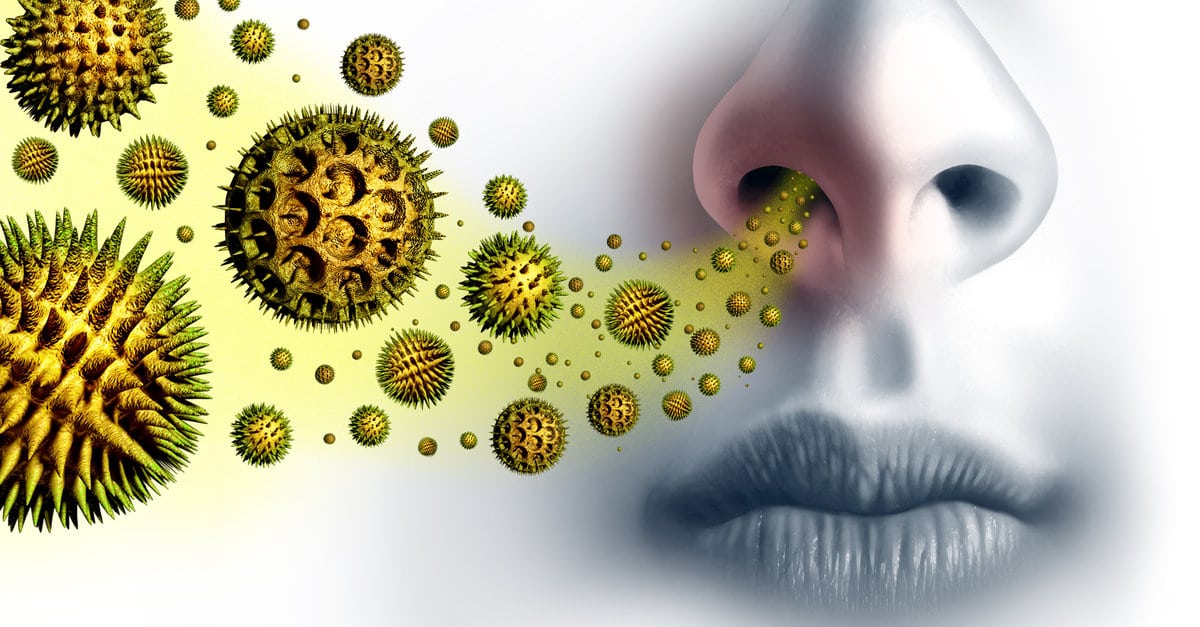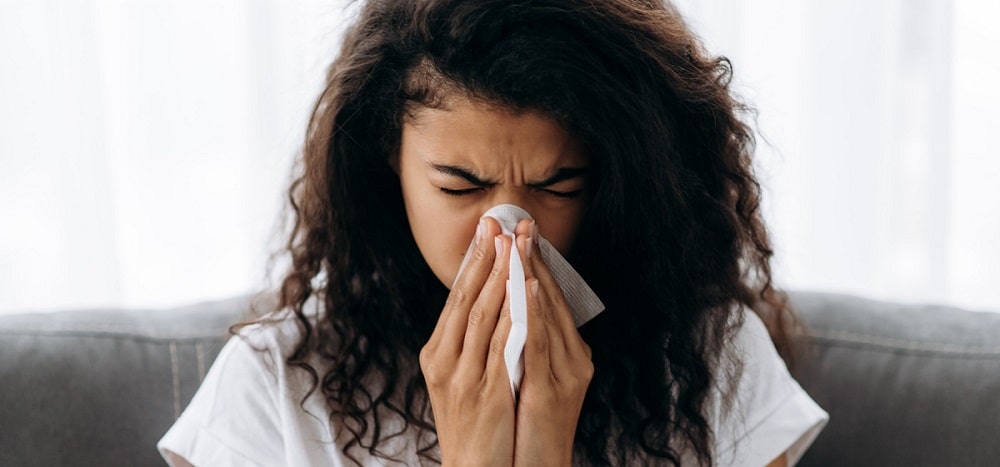Adult Allergies

OVERVIEW: WHAT IS ALLERGIC RHINITIS?
Allergic rhinitis is an inflammatory condition of the nasal lining caused by an allergic reaction to airborne triggers which can differ from person to person. Common triggers include pollen, grass, pet fur and dust mites.2
It can occur during a specific season, most commonly spring, when pollen counts are high, which is termed seasonal allergic rhinitis, or throughout the year, termed perennial allergic rhinitis.3
When an allergen (trigger) enters the body, it mounts an antibody response with IgE (immunoglobulin E). People with allergies have higher levels of IgE.3 Mast cells (cells in the surface tissue), such as nasal mucosa, which are key players in inflammatory responses release a number of substances including histamine, IL-4, IL-13, TNF-α, leukotrienes and prostaglandins.5
These substances cause itching, swelling, and ‘leaking’ fluid from cells which, in turn, lead to the symptoms of allergic rhinitis.
CAUSES AND RISK FACTORS
There are multiple triggers of allergic rhinitis, which differ between people. Some underlying conditions may increase susceptibility to allergic rhinitis.
Common triggers
Allergic rhinitis triggers are often seasonal and include:2
- Pollen from trees, flowers, and grasses (common in spring)
- Dust mites
- Pet fur (may be worse in winter when houses are closed up)
- Perfumes, smoke, and other air pollutants
Risk factors
Allergic rhinitis is thought to be genetic and can be worsened by frequent exposure to triggers.3,6 A number of conditions can predispose people to allergic rhinitis or cause it to be more severe. These include:2
- Other allergic conditions, such as asthma*
- Atopic dermatitis (eczema)
- A family history of allergy
- Living in an area with high exposure to triggers
- History of maternal smoking in first year of life
*Up to 80% of asthmatics also have allergies.7
SYMPTOMS OF ALLERGIC RHINITIS
The initial symptoms of allergic rhinitis may be confused with those of a common cold. Unlike colds, it is not contagious and not associated with fever, but is characterised by watery discharge from the nose, starts immediately after exposure to a trigger and resolves when the trigger is removed. The common cold starts 1-3 days after exposure to the virus and resolves within 3-7 days.2,3
Common symptoms of allergic rhinitis include:1-4
- Nasal congestion
- Sneezing and runny nose
- Cough
- Postnasal drip
- Itching of the nose, throat, and eyes
- Excessive tear production
- Sleep disturbances and difficulty waking
- Daytime sleepiness and dysfunction
Complications may include worsening asthma, sinusitis, and otitis media.2
BURDEN ON QUALITY OF LIFE
Allergic rhinitis places a large burden on quality of life: lack of sleep and constant itching and running nose can lead to irritability, work/school absences and decreased productivity. In today’s fast-paced lifestyle, this is far from ideal.2
Costs, both direct (doctor’s visits and medication) and indirect (lost workdays and productivity) of allergic rhinitis can be significant.6
When to see a doctor
You should seek medical attention if:2
- Symptoms of allergic rhinitis are not relieved when using allergy medication
- You have other conditions which may worsen the condition, e.g., asthma, sinusitis and/or nasal polyps
DIAGNOSIS OF ALLERGIC RHINITIS
Diagnosis of mild allergic rhinitis is usually made based on symptoms.3 More severe allergic rhinitis may require allergy testing, to establish triggers. Allergy testing is done by the skin prick test and/or blood tests.2,3
Skin prick test
During the skin prick test a small drop of each suspected allergen (trigger) is placed on the skin and then the skin is scratched with a sterile needle. If the skin becomes red and/or swells, sensitisation to that allergen is confirmed and allergy to that allergen is probable.3
The identification of triggers allows for its possible avoidance.
Allergy blood test
Several blood tests may also be performed to aid diagnosis of allergic rhinitis, such as IgE antibody testing.3
TREATMENT OF ALLERGIC RHINITIS
Antihistamines
Antihistamines block histamine which can alleviate the itching, sneezing and runny nose.2 Most commonly, they are given orally, but nasal sprays and eye drops are also available, which act locally.
Corticosteroids
Corticosteroids reduce inflammation and decrease the production of substances that cause the allergic response.3 They are often the first choice for treating allergic rhinitis.2
Decongestants
Decongestants can help to control symptoms (such as inflammation), but not the cause of allergic rhinitis. They decrease swelling in the nose, allowing easier breathing. If used for too long (> 5 days), they can cause rebound congestion when they are stopped.3
Leukotriene modifiers
Leukotriene modifiers act on leukotrienes, which form part of the allergic response. They are generally not used as first-line treatment.3
Combination treatment
Intranasal combinations of antihistamine and corticosteroids are available, reducing the need for polypharmacy and treating allergic rhinitis using dual mechanisms with both short-acting and long-acting effects.8
- A combination nasal spray has been developed to meet the demand for improved symptom control.
- The first combination of an INCS and IAH in South Africa, thus eliminating the need for polypharmacy
- Rapid onset of action, within 10 – 15 minutes
- Provides both nasal and ocular symptom relief
- Sustained symptom and QOL improvement from day 1
PREVENTION AND LIFESTYLE CHANGES
Complete avoidance of allergic rhinitis triggers is not always possible, but can minimise the risk and severity of the allergic rhinitis. 2
In many people, long-term treatment, prescribed by a doctor (often only during ‘allergy season’, i.e., before exposure to allergens) can minimise symptoms and the burden on quality of life.
For more information, speak to your healthcare professional!
Last reviewed : 5 May 2024
Related Brochures

blocked-nose

allergic-rhinitis
WHAT IS ALLERGIC RHINITIS?
